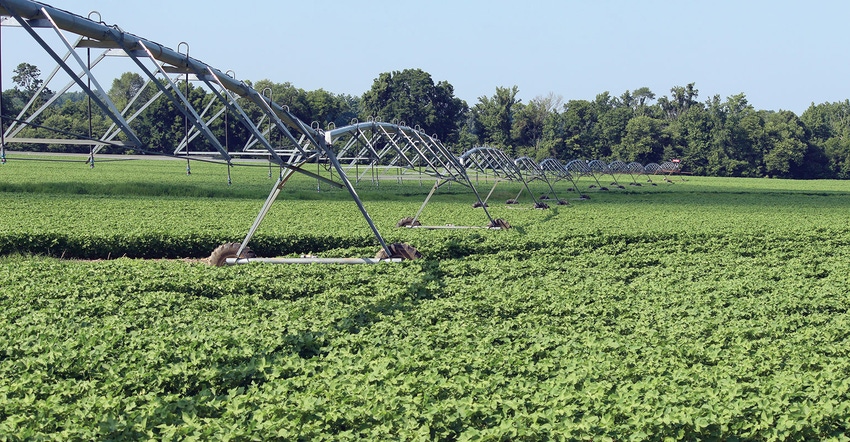
According to the 2019 Mid-South Land Values and Lease Trends Report that was recently released by the American Society of Farm Managers and Rural Appraisers (ASFMRA), from 2000 until early 2008, prices for farmland increased about 1 to 2 percent annually. When the ethanol mandate was implemented in 2008, it gave grain prices a shot in the arm and farmland price increases began to accelerate.
Clay Caver, vice president, AXA Equitable AgriFinance, LLC, and Tyler Mullins, vice president/appraiser with the Mississippi Land Bank, serve on the Project Committee of the Mid-South ASFMRA local chapter.
Between 2008 and 2014, farming brought improved net operating income. “Prices were good and production yields were generally high. That captured the attention of farmland investors,” says Caver. “Real estate investment trusts and hedge and pension fund managers became farmland buyers because of the good return on investment from Delta region farmland. They were basically getting return on top of return — a cash on cash rental return, and then the appreciation rate return.”
Despite the fall of commodity prices, which started around 2014, investor and owner/operator interest in farmland has remained relatively strong in the Mississippi Delta. “In my opinion, this level of interest is buoyed by three legs supporting farmland prices,” says Caver. “Those three factors are farm production profitability, government price support programs, and low long-term interest rates.”
Caver has not seen a trend in farmland sales data to indicate a significant pullback of cropland prices in the Mid-South. “This is despite many farmers having missed an entire planting season and a strong uptick in prevented plantings,” says Caver.
Included in the 2019 report is a chart produced by USDA reflecting land value survey trends in Illinois and Iowa versus Mississippi that presents the changes in relative price per-acre in Mississippi, compared to farmland in those Midwest states.
Why are Corn Belt land prices so high? Caver believes in addition to reasonably consistent crop yields, soils, and weather, a strong operator/owner culture exists in the Midwest. “That trend, plus the smaller size of typical Corn Belt properties, often leads to more competition to purchase these smaller tracts of individually owned or family-owned farmland,” says Caver. “You don’t have multi-thousand-acre tracts of land for sale very often there. In the Delta, those types of transactions are not that unusual.”
Influences
When someone is in the market for farmland, several characteristics either increase or decrease the land’s potential value. “Soil type is always one of the first considerations, but investors want to know if there have been improvements made to the land in the form of irrigation (pivot or furrow), and/or has the ground been precision leveled,” says Mullins.
“There hasn’t been a lot of good irrigated cotton ground traded in the last 18 months, but now we’re seeing some of that type of property coming to the market and it’s commanding a high price.”
Mullins has seen some added economic pressure on rented land of late. In certain parts of the Mississippi Delta, property taxes are increasing, and the landowner who is paying those taxes out of the tenant’s rent, is going back to the tenant and asking to raise the rent.
“With commodity prices trending downward right now, there’s an interesting storm brewing in that part of the Mid-South, especially when you’re talking about leased land,” says Mullins. “Farmers are more strategically placing their crops holding the most yield potential on their best ground and really penciling out inputs before applying them because margins are tight.”
Because so many farmers are nearing retirement, there are, unfortunately, some generational transfers also occurring because there are no family members to take over the operation. “When this happens, chances are high those properties will end up being sold to several individuals or investors,” says Caver.
“Those buyers also understand what’s going on with the Mississippi River Valley Alluvial Aquifer, and although we haven’t seen that concern directly impact land sales, it is on the radar of investors.”
ASFMRA report
The perspective in the recently released ASFMRA report offers a more satellite view of land values across the Mid-South. The four states are broken down into units with land values segmented by classes A, B, and C. “The A class reflects land that’s been precision leveled, class B reflects furrow-irrigated land, and C reflects farmland that has pivot irrigation,” says Mullins. “Although land sales with pivots are declining, all three classes are remarkably parallel across the board.”
The land value report recently released by USDA reflects an average assessment for irrigated land in Mississippi between $3,500 to $3,800 per acre. “Those figures are considerably lower than what you will find in the 2019 ASFMRA Mid-South Land Values and Lease Trends Report. The USDA report also provides more of a satellite view because their information isn’t broken down into detailed categories,” says Mullins.
“The ASFMRA report contains information taken from a more boots-on-the-ground standpoint. I believe this report provides information that will allow farmers and landowners to see and understand what characteristics of their property drive land values. It’s good for them to know their hard work improving the land through the years has paid off.”
Mullins reports that the 2020 Mid-South Land Values Report will be available in a free, online version early in the second quarter of 2020.
About the Author(s)
You May Also Like




